(and everything else)
Self-obsession is humanity’s lot. We see only out of our own eyes, after all, so of course we prioritize ourselves, each of us straddled with a serious case of main character syndrome. But don’t feel bad. As Luke 23:34 says: “Forgive them father, for they know not what they do.”
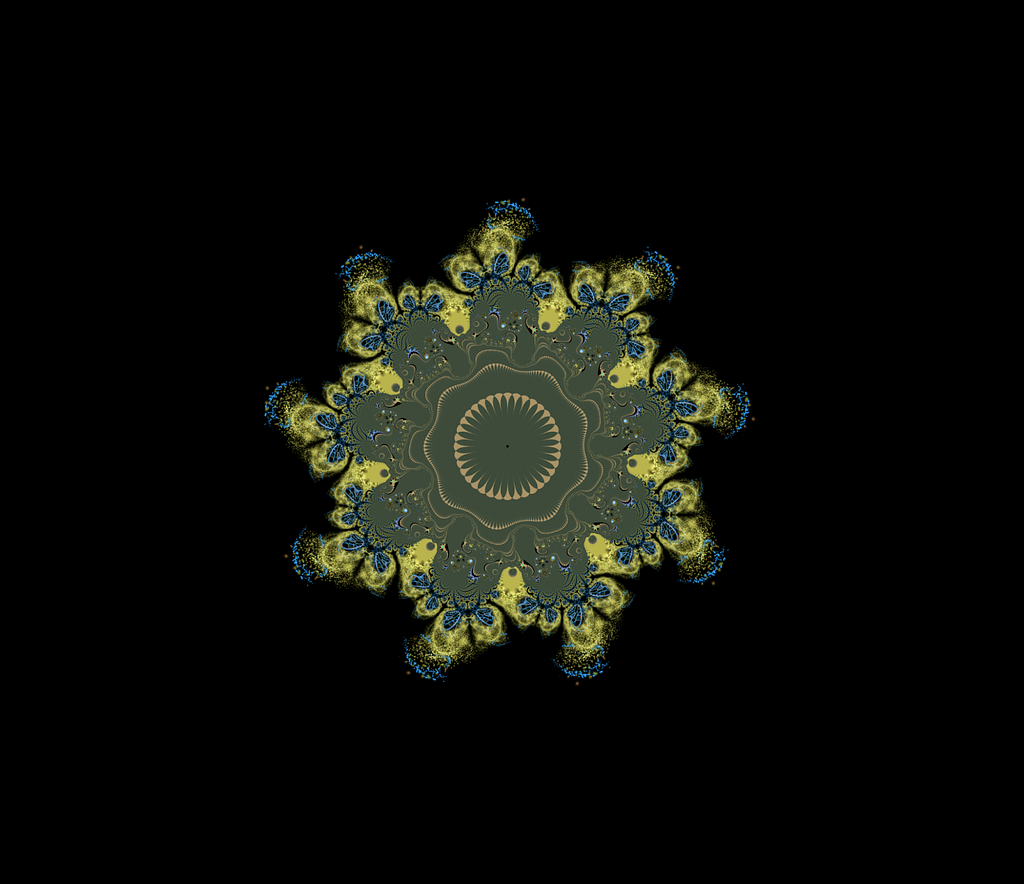
The result of our individual self-obsession is a collective one as well. We human beings love centering ourselves in the story — hell, the geography — of the universe. It seemed perfectly reasonable to believe that Earth was the center of the universe, and until Copernicus came along in the 16th century to dispel that notion, it seemed both physically and metaphorically sufficient to suggest that all of creation revolved around us. This calls to mind a gripe I had in my youth with organized religion: How could these Gods and Messiahs, with their well-touted omniscience, really care so singularly about human beings when there was an entire infinitely-expanding universe to worry about?
It is neither surprising nor dismaying that human beings are therefore artistry’s favorite subject. If self-obsession doesn’t live in the arts, then where does it? Rarely does an artist appears who seems keen on superseding this self-obsession. Though their aesthetics rarely match on another’s — I find myself thinking of Frida Kahlo and of Ansel Adams, though that’s a topic for another essay — you find in all their works the suggestion of a mind searching for connection beyond themselves.
The great artists can art to connect their experience to our own. But it takes some other kind of artist entirely to connect us with the infinite everything: the all-spirit, all things, “the truth.”
Which brings us to math.
And to Daïm Aggott-Hönsch, the mathematical artist and self-proclaimed Apeirographer. With Apeirography, Aggott-Hönsch seeks to “recognize mathematics as an exceptional, timeless, and uniquely immutable subject utterly worthy of study and creative exploration.” In doing so, in using the same mathematical principles to evoke man and the cosmos alike, he reveals the connective tissues which bind each of us to the universe.

His works make me think about the concept of infinity. Both kinds of infinity, that is. The Big Infinity is the one we’re all familiar with: the unfathomable collection of numbers beginning with 0 and stretching upwards into perpetuity. But we must also consider the Small Infinities. Between every two numbers — 1 and 2, 1.1 and 1.2, 1.11 and 1.12 — are an infinite set of continuously smaller and smaller divisions. As long as the Division sign, ÷, exists, we can dig endlessly down into the subatomic depths between numbers, adding further and further decimal points, coming to tinier and tinier conclusions. The Big Infinity is all-encompassing, but the Small Infinities are literally everywhere.
In Aggott-Hönsch’s work, we human beings are presented as just one beautiful, perpetual, multifaceted Small Infinity. Human experience is unquantifiably vast, but it is only an infinitesimal sliver of the larger universe. Aggott-Hönsch scours human history — backwards from the Renaissance through the Dark Ages, sidestepping the Ancient Greeks all the way to and beyond the Mesopotamians — so as to evoke and link together the entirety of the Small Infinity we ourselves represent.
Which is, in itself, a triumph. But to explore Aggott-Hönsch’s oeuvre is to come constantly in contact with that larger infinity too, the All History which contains and precedes and permits all things. It’s math. The universe is a mathematical representation, for math dictates physics and chemistry, the two pillars of creation. Aggott-Hönsch told me, “I see mathematics as being populated with an infinite number of incredible objects and entities which, some of them nobody has ever seen before.” Within his works are a number of these mathematical objects, expressions of math which could exist, but probably didn’t, and now do. Aggott-Hönsch plumbs the depths of the Big Infinity to find them, these objects which evoke the expanses they themselves were plucked from, and which, through juxtaposition, we find ourselves reflected in.

In linking our human past to the All-Past, in using the same methods to represent both, in weaving the two throughout his oeuvre, Aggott-Hönsch reveals mathematics as the one underlying current which permeates all things. Carl Sagan once said “We’re made of star stuff.” Aggott-Hönsch’s work makes me think that even Sagan was thinking too small-scale.
Our Past
This is perhaps my favorite little quirk of digital art: In using highly-advanced digital procedures (like AI or blockchain) to create artwork which references the past, artists automatically create a bridge between the modern era and the era of their subjects. Daïm Aggott-Hönsch is not just keenly aware of this bridge, but centralizes it, making it the centerpiece of the works themselves.
For a quintessential example, look no further than his most recent piece: Portrait of apprehension (Self portrait?). This is a play on Dutch artist Jan van Eyck’s 1433 masterwork, Portrait of a Man (Self Portrait?), and one in which Aggott-Hönsch overloads the original artist’s composition with conspicuously-digital designs. This AI-assisted artwork contains massive amounts of fine, digital detail, whether that means the abstract and overlapping polygons which have been snuck into the figure’s skin and woven into the fabric of his turban, or in the strange and blocky textures which have been retrofitted over van Eyck’s original hyper-realistic oil paints. This new composition is blocky and robotic. It is simultaneously of van Eyck’s time and of ours. Sapping the piece of either era is to destroy the composition entirely. Portrait of apprehension (Self portrait?) bridges epochs and intentions across a ~700 year gap.

In Les Frères-Empereurs Néonapoléon (and Le sorelle Gioconde dell’orbitale 29 as well), Aggott-Hönsch takes the same principle and applies it to the kind of baroque royalty seen throughout Renaissance and Neoclassical art, though here the artist plays with both textual and subtextual links between that time and ours. Aesthetically, this is just a sumptuous piece. Big, bombastic, and downright dripping with gold. Gold! Precious, shimmering gold! Two kings sit on their thrones, crowned in gilded laurels, draped with enormous velvet capes, and wielding bejeweled scepters. The artwork itself makes clear that digital techniques are at work, what with the gentle photoshopping — and subsequent oversaturating — of faces, and with the absolutely identical halving of the piece, as if the original composition was copied, flipped, and pasted beside it. And by bestowing European royalty status upon both a black man and an Asian man, Aggott-Hönsch transports our modern cultural reflection of white-and-European-dominated Renaissance art back onto the time period from whence those reflections stemmed. In this way, the piece’s subjects commune with its inspiration. Les Frères-Empereurs Néonapoléon could not have come from the time period which it evokes, but yet the evocation is undeniable.
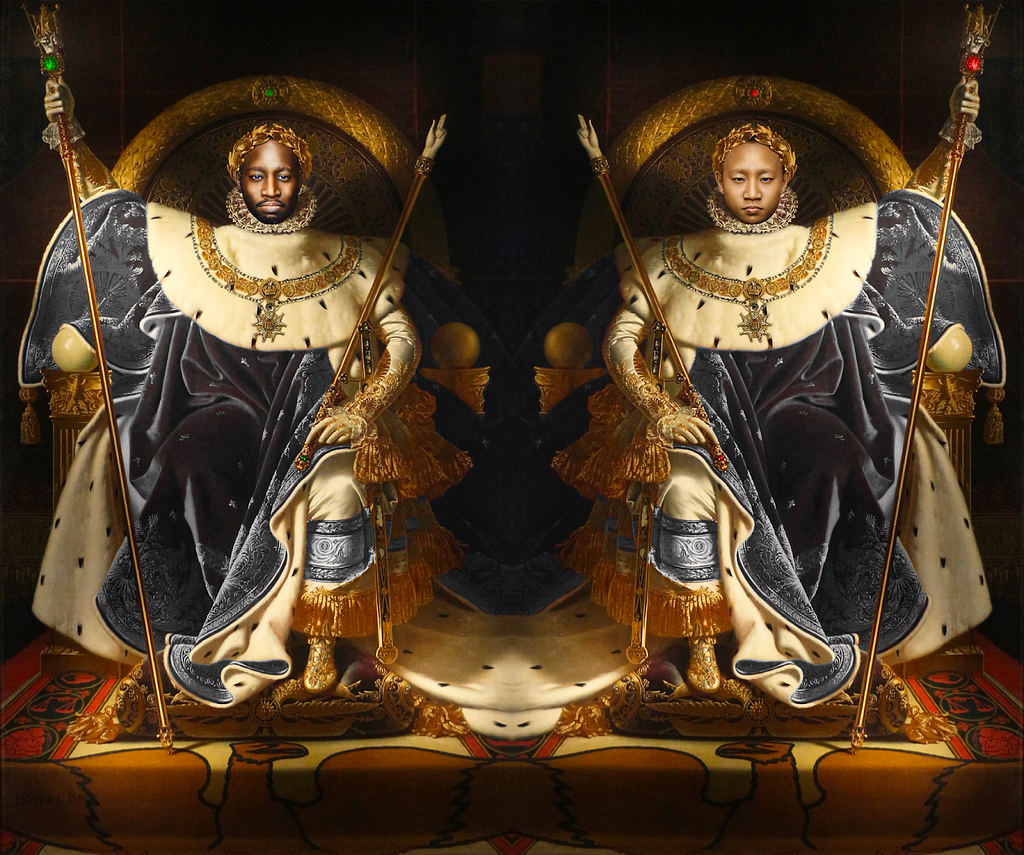
In works like Ancestral Memory, Aggott-Hönsch stretches his eye even further back to the dawn of human civilization, thus including in his works the full scope of the small human infinity.
In my opinion, Ancestral Memory is the crown jewel of Aggott-Hönsch’s works, and deserves an essay in its own right. The artwork itself is a 6-minute audiovisual experience, a piece of what the artist calls “Slow Art.” While it is not flashy or frenetic, it is an evolving and ever-shifting video. “It’s something that you get most out of as a viewer if you’re able and willing to put in the time to engage with it for the full duration…it’s meant to be the sort of thing that doesn’t necessarily actually expect you to stare at it unblinking…” Aggott-Hönsch told me.
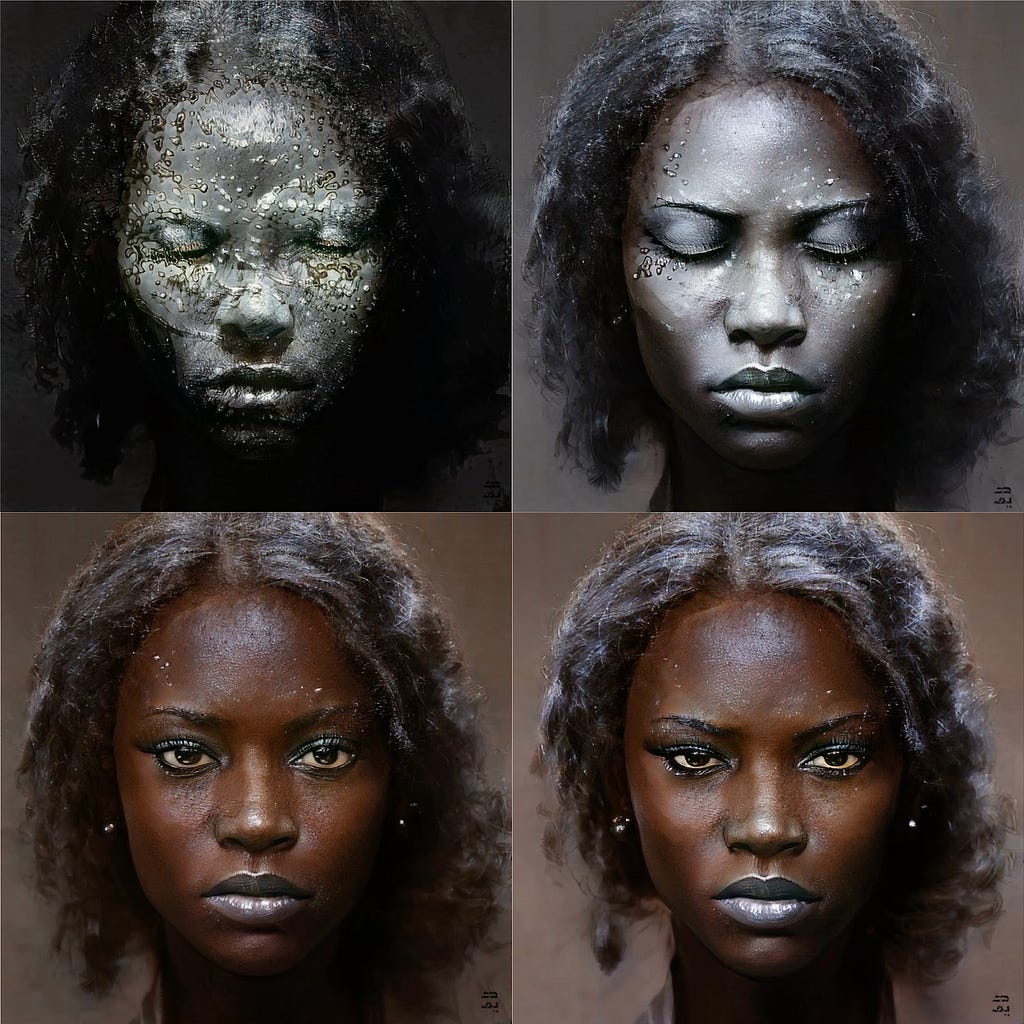
Over the course of Ancestral Memory’s six minutes, a stone-carved female face slowly awakens, frame-by frame, becoming more and more real, recognizable, and like ourselves. It is as if the woman is literally emerging from the stone, losing her inanimate lifelessness cheek by cheek, eyelid by eyelid, until she is with us, alive once more. Aggott-Hönsch’s description of the piece is as follows:
“All humanity traces its deepest ancestry back to Africa. If the long forgotten and oft’ eagerly suppressed memories infused within our very DNA were ever to awaken, what would our venerable foremothers think of our world and of us? What judgment would they pass?”
The artist here overtly references his intent to connect us with our shared ancestors, these All-Mothers who are the well-spring from which our entire Small Infinity has flowed.
In all these works, Aggott-Hönsch’s stretches his breadth of hyper-modern digital art-making tools back across the scope of our shared human past, touching his finger down here and there, subverting images so that they rest in two diametric worlds: their own and ours. With computer tools, themselves mathematical expressions, the entirety of human history becomes a single endless string upon which all the Small Infinities of our lives — our thoughts, our movements, our actions, our ancestries, our loves and losses — hang together.
But then Aggott-Hönsch continues to zoom out. And, yes, we can see our string there too, but it hangs amongst an unquantifiable expanse of other strings, all of which look just like our own.
The All-Past
As a teenager, I developed a small obsession with physics. Not “Physics Class” physics (I never had much a mind for numbers, myself), but the great and tiny manifestations of those physics. I spent hours jumping from Wikipedia page to Wikipedia page to learn about our universe’s mightiest forces. The superposition of electrons. Black holes. Dark matter intrigued me. I learned a lot about Quasars. And did you know that, out in the far reaches of space, shared gravitational pulls link together many billions of galaxies into single superstructures called Great Walls? At the largest and lowest levels, physics reveals to us forces and objects which defy all of what we think we understand about the universe. The very fundamental fabric of our existence — all the quarks and Higgs-Bosons — remains unknown to we who owe everything to them.
Constantly, we are developing new technologies which allow us to observe, or learn the existence of, entirely unbelievable items in our universe. CERN’s Large Hadron Collider is one such example. The James Webb Space Telescope too. All reveal to us a host of objects and forces big and small which alter our understanding of the universe. To embark on a mathematical journey at this level is to meet unexpected friends, and to tongue the very outer limits of creation.
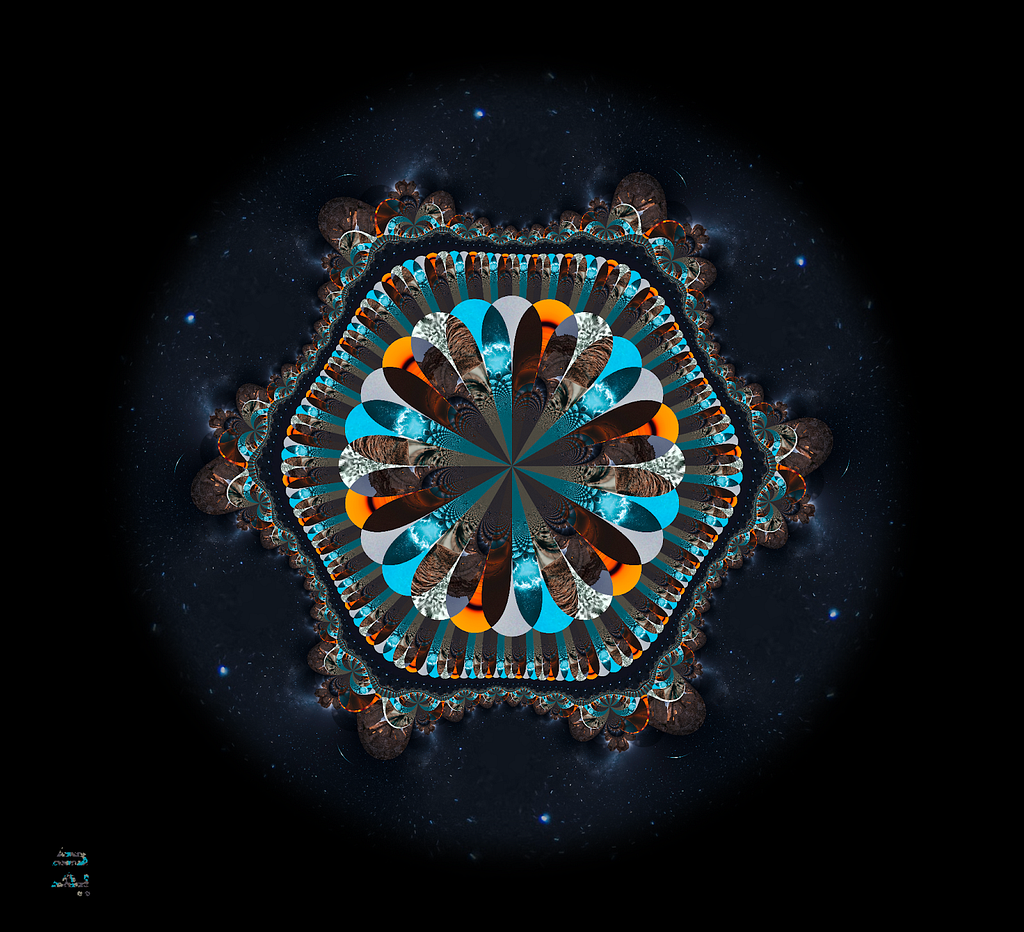
In this fractal-based, abstract, and more outwardly mathematic segment of Daïm Aggott-Hönsch’s oeuvre, the artist captures all the tremendous power of math taken to its logical conclusions, be that on a macro or micro scale.
These mandalas are Aggott-Hönsch’s unique expression of so-called “Pickover Biomorphs,” shapes discovered by and named after Dr. Clifford A. Pickover. Pickover’s Biomorphs are fractal forms related to the Mandelbrot and Julia sets, themselves the foundation of much fractal art. Pickover Biomorphs generally emulate biological organisms: germs and single-cells and amoebas. Indeed, Aggott-Hönsch’s also share this quality. But the artist carefully adds details to these compositions which broaden their scope beyond just the biological (thanks to Daïm for his input with this paragraph).
In them are slivers of the human, the single-celled, the cosmic, and the quantum realms. Aggott-Hönsch’s fractal artworks represent the entire overarching settings wherein our entire human journey takes place. We are but a fiber of a feather, yet, we remain inextricable aspects of these incalculable heavens. We too matter, we too are beautiful, and math has really just knocked it out of the park in creating us.
These universal works, like Cosmic Eukaryote above, dwarf mere beauty. They are representations of concepts the human mind glazes over thinking about, our jaws slack as we try to imagine something a billion light years across, or as we consider the many trillions of identical atoms which exist on the head of a pin. These pieces are rendered in an intimidating amount of pixels (I had to screenshot the original images just to get them into this piece) and with incredible resolution. Even as we look directly at them, they are beyond our understanding or our conception. We must let go of our desire to know and simply observe, accept.
These pieces don’t all take place in the same intergalactic starfield that Cosmic Eukaryote does. Aggott-Hönsch understands that math is pervasive in realms beyond just the cosmos. Take Solar Anomaly, which, despite its title, takes place in a kind of void which is not necessarily outer space. Its smoothness is striking. The long tendrils emerging from Solar Anomaly’s fractalized center conjure familiar connotations: Hair, hoop earrings, the white-capped tips of curling waves. If we zoom in closer, however, (and I implore you to do so on the original image) the composition’s complexity is revealed. We are again out of our depth, staring at an intricacy we can’t quite grasp.
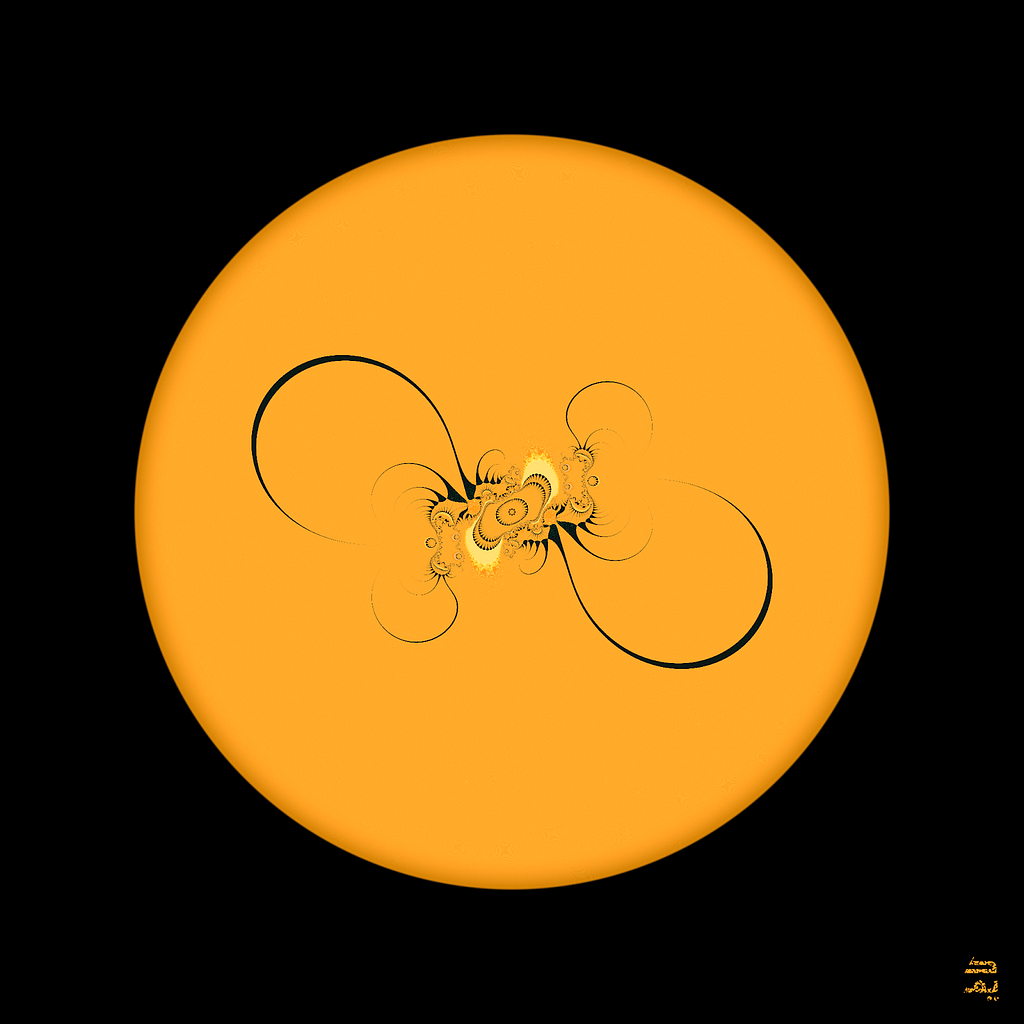
These fractal-based images strike me as the perfect encapsulation device for the kind of heavenly connotations Aggott-Hönsch seems to chase. That stems from the nature of their repetitious design. This design is also like a kind of mirroring, an endless series of copy-and-pasted shapes. These tiny, perfect objects exist in their own internal worlds, unaware that they are mere elements — particles even — in a larger whole. Like the atoms which make up our cells, the cells which make up our bodies, our bodies which make up our civilizations, and so on and so forth. These individual shapes — each its own Small Infinity — are both at odds with and inseparable from the larger, greater whole. They exist perpetually in this contradictory state of wholeness and isolation.
Sound familiar?
The rub of all Aggott-Hönsch’s artworks is that everything — from the abstract and cosmic to the skin-covered and scepter-carrying — is cut from the same mathematical cloth. The same mathematics have made them all possible.
I’m reminded of the Hindu concept of Brahma and Atman. I’m oversimplyifying, but Brahma is the permeating life force of the universe, and every individual God — Shiva, Ganesh, Krishna among them — is a different expression of the one Brahma. But so are our souls, as each of us, at our deepest core, contains a shred of the Brahma as well; this is called the Atman. We humans beings are merely windswept fragments of the same underlying divinity which binds the universe itself — heavens and earth — together.
Aggott-Hönsch’s description for his piece Geometer’s Devotion echoes this idea. It reads “The best of Geometers worship through skillful manipulations of the fabric of space itself to reveal the thereuntil unseen manifestations of the sacred that surrounds us all.” Or, better yet, which permeates us all.
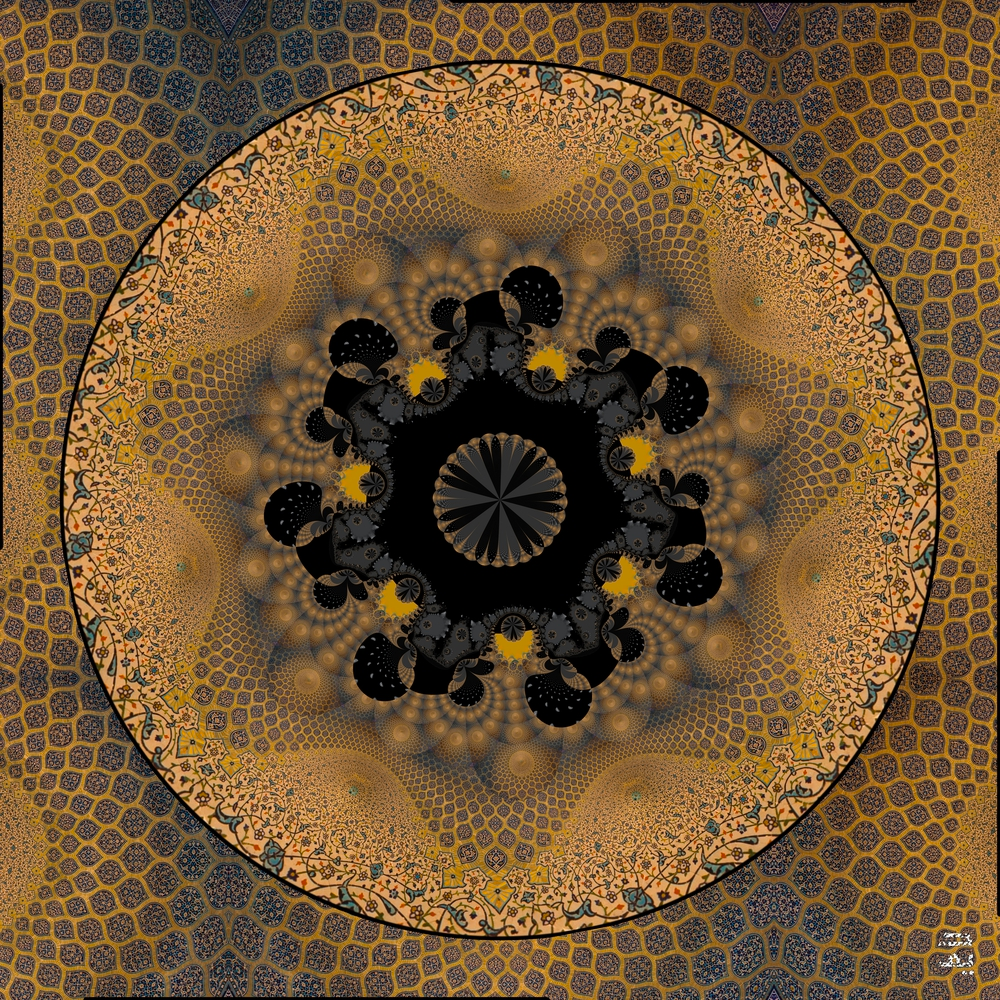
Within this kind of compositional strategy — as is literally so in Signs and Portents below — Aggott-Hönsch codifies the Atman within all thinking, self-obsessed things. Our perceived isolation from the greater universe is both our own conscious doing and something which has been imposed on us by the mental, spiritual, and physical limitations of our species. But in Signs and Portents, for example, by literally encoding bits of the human body into the representation of the All-Past, Aggott-Hönsch seems to both understand and mitigate our human smallness. He lets us see for ourselves that despite the apparent lack of relationship we have to these shapes and superstructures that float endlessly in the distant scattershot universe, our dangling strings are all cut from the same material.

Aggott-Hönsch’s human artwork bridges time periods and comprehensions, and in doing so makes the arbitrary separations between them trivial. Does he not do the same thing with his cosmic artworks as well? If we can only see a thing from way up-close, with intense aggrandizement of our limited perception, we will indeed all appear isolated, mere nuances within a larger, colder, randomized whole.
But when we zoom out, we see the entire tapestry. We may only be a small part of it, but we’re still a part of it, bound together by the logic of the frame. And the same mathematical principles which have made me — the writer — and you — dear reader — and Aggott-Hönsch — the artist — are responsible for his artwork too. The loop is closed. The cycle is endless.